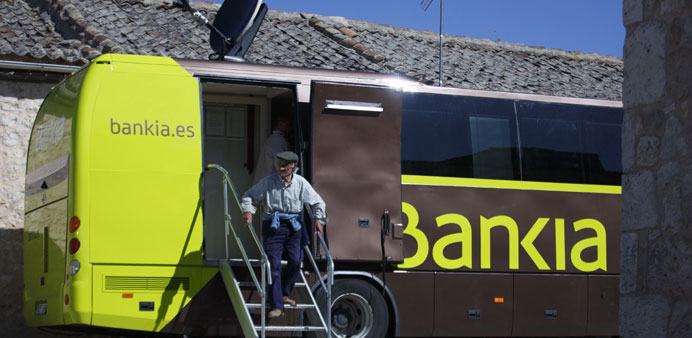
Banks slashed 5,500 branches across the European Union last year, 2.5% of the total, leaving the region with 20,000 fewer outlets than it had when the financial industry was plunged into crisis in 2008.
Last year’s cuts come after 7,200 branches were axed in 2011, according to data analysed by Reuters from European Central Bank statistics.
Banks across Europe have been closing branches in a bid to trim operating costs and improve their battered earnings. Consumer take-up of online and telephone banking services has accelerated the trend.
The data show EU banks cut 8% of branches in aggregate in the four years to the end of 2012, leaving 218,687 branches, or one for every 2,300 people.
Last year’s sharpest cuts were largely contained to the embattled periphery.
Crisis-stricken Greece saw one of the biggest contractions in 2012, shedding 5.7% of its outlets, as mergers of local banks led to 219 branch closures. The trend is expected to continue into 2013 as Piraeus shuts some of the 312 branches it snapped up from stricken Cypriot lenders in March.
Spain, where massive loan losses have put banks under fierce pressure to cut costs, lost 4.9%, or 1,963, of its branches in 2012.
Ireland’s branch network contracted by 3.3% and is expected to shrink again in 2013, while Italy’s network was 3.1% smaller by the end of the year.
Branch numbers were on the rise in some eastern European countries including Poland (up 4%), the Czech Republic (up 2.3%) and Lithuania (up 1.8%).
In Britain, the ECB data showed the number of branches remained little changed at 11,870.
The ECB gathers data on lenders’ branch networks across the EU, and the data Reuters reviewed included the 27 EU member states at the end of 2012. Croatia has since become the 28th member.
ECB data can differ from statistics from national banking groups, depending on criteria for inclusion.
The cuts have been most severe in Spain, unravelling years of expansion by regional savings banks, which had landed it with the biggest network in Europe.
Its branch numbers were down 17% by the end of 2012 from four years earlier. But at just over 38,200 branches, Spain still had more branches per head than any country in Europe — one for every 1,210 people. A European bailout of weak lenders last year, including Bankia, was conditional on them shrinking further.
In remote areas such as Maderuelo, 150km from Madrid, many are grateful they have the green and brown bus banking service, which just comes once a month but villagers are happy.
Elsewhere, newcomers to the service might not count themselves so lucky; in the eastern region of Valencia, the bank is rolling out the bus service for the first time as it cuts over 1,000 sites across the country.
Other countries such as France are also ripe for cuts. France had the most branches in Europe by the end of last year, with nearly 38,450, or one for every 1,709 people, behind only Spain and Cyprus per person.
Cyprus had one branch per 1,265 people, and its banks, rocked by links to the tumbling Greek economy, also have to shrink after an EU bailout.
Many banks admit they are not cutting branches as quickly as they should, wary of putting off clients just as bank earnings are recovering, and fearful of a public or political backlash in countries like Britain, where some of the biggest lenders were rescued by the taxpayer.
“When you close a branch, you run the danger of losing at least a few clients,” said Paris-based Fabrice Asvazadourian, global co-head of financial services at consultant Roland Berger. “It’s the moment that gives people an excuse to consider switching banks.”
French banks are cutting branches at a slower pace than Spanish peers, trimming only 79 in 2012, ECB data show.
It had shed less than 3% of its network in the four years to the end of 2012, while 5% of UK branches and more than 8% of German ones pulled down the shutters for the last time. The number of branches plummeted by a third in Denmark and by a quarter in the Netherlands.
A flurry of Spanish bank mergers in the past three years in part explains the deep cuts. A 2008 property crash that gutted banks’ earnings and led to a European rescue added urgency to the cull as the economy fell into recession for the best part of the last five years.
The country shed nearly 700 more branches in the first three months of 2013, data from the Bank of Spain showed.
“In Spain, the economic problems have been a catalyst. Perhaps without that things could have carried on the way they were for a little longer,” said a Madrid-based banker from Barclays.
Subsidising unprofitable branches is a luxury few can now afford. Branches account for around 60% of retail banking costs, including property and refurbishment spending as well as staff pay, Deutsche Bank researchers estimated.
Formats such as internet banking are adding to the incentive to shut outlets. These could yield €15bn to 20bn in extra earnings by 2021 for European banks, according to consultants McKinsey and industry body the European Financial Management and Marketing Association.
In France, major banks such as BNP Paribas, Societe Generale and Credit Agricole have made clear their intention to cut costs as retail revenues are squeezed by belt-tightening consumers.
In Britain, with a branch network one-third of France’s or Spain’s, banks have almost halved branch numbers since 1990.
Senior bankers privately say a network of 700-800 outlets would be an optimal size for a bank covering all of Britain. None of the big five have so few. Lloyds has three times that (2,260), and Royal Bank of Scotland more than twice (1,750), excluding almost 1,000 branches they are already selling between them.
Cuts across Europe should allow banks to improve the branches that remain, and many are targeting a “look and feel” akin to the stores of consumer electronics powerhouse Apple , combining tellers and technology.
But it’s a transition that risks leaving millions of clients behind, unless banks keep up minimal physical services. In Corral de Ayllon, a Spanish village of 60-odd inhabitants near Maderuelo, where most people are farmers or pensioners, changing habits will be hard.
Like many in the village, retired local farmer Tomas Aribas withdraws cash using account booklets and fears that in future the banking service might be inaccessible to him and his neighbours.
“We’d have to learn about the Internet to be able to use it,” he said.
Source: Agencies












